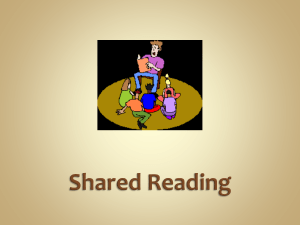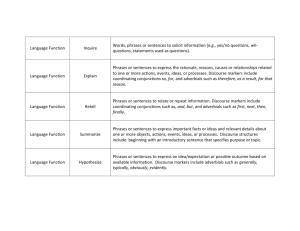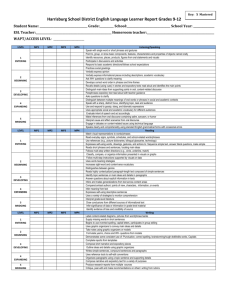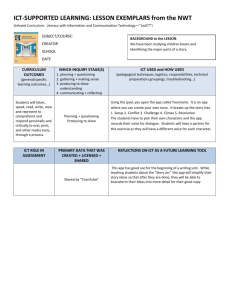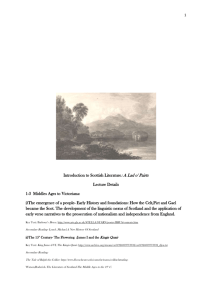Teacher: Leslie Colvin Week 1: August 18
advertisement
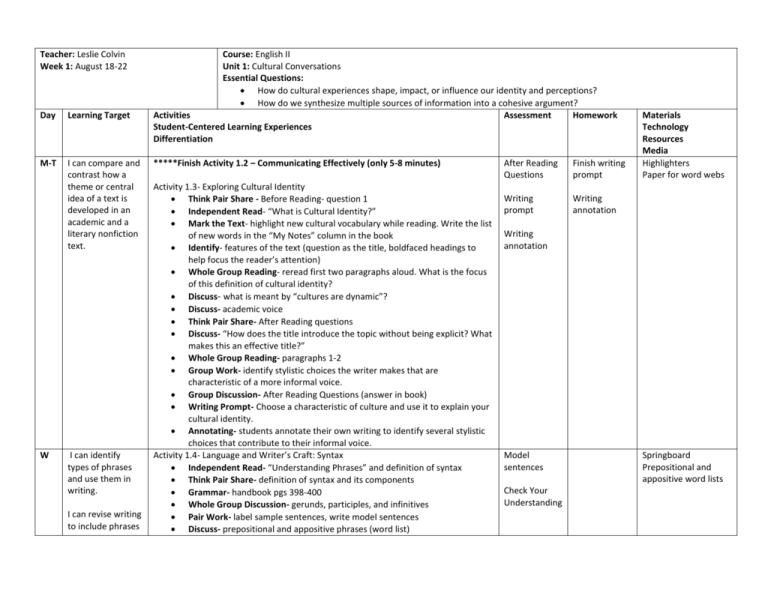
Teacher: Leslie Colvin Week 1: August 18-22 Day Learning Target M-T I can compare and contrast how a theme or central idea of a text is developed in an academic and a literary nonfiction text. W I can identify types of phrases and use them in writing. I can revise writing to include phrases Course: English II Unit 1: Cultural Conversations Essential Questions: How do cultural experiences shape, impact, or influence our identity and perceptions? How do we synthesize multiple sources of information into a cohesive argument? Activities Assessment Homework Student-Centered Learning Experiences Differentiation *****Finish Activity 1.2 – Communicating Effectively (only 5-8 minutes) Activity 1.3- Exploring Cultural Identity Think Pair Share - Before Reading- question 1 Independent Read- “What is Cultural Identity?” Mark the Text- highlight new cultural vocabulary while reading. Write the list of new words in the “My Notes” column in the book Identify- features of the text (question as the title, boldfaced headings to help focus the reader’s attention) Whole Group Reading- reread first two paragraphs aloud. What is the focus of this definition of cultural identity? Discuss- what is meant by “cultures are dynamic”? Discuss- academic voice Think Pair Share- After Reading questions Discuss- “How does the title introduce the topic without being explicit? What makes this an effective title?” Whole Group Reading- paragraphs 1-2 Group Work- identify stylistic choices the writer makes that are characteristic of a more informal voice. Group Discussion- After Reading Questions (answer in book) Writing Prompt- Choose a characteristic of culture and use it to explain your cultural identity. Annotating- students annotate their own writing to identify several stylistic choices that contribute to their informal voice. Activity 1.4- Language and Writer’s Craft: Syntax Independent Read- “Understanding Phrases” and definition of syntax Think Pair Share- definition of syntax and its components Grammar- handbook pgs 398-400 Whole Group Discussion- gerunds, participles, and infinitives Pair Work- label sample sentences, write model sentences Discuss- prepositional and appositive phrases (word list) After Reading Questions Finish writing prompt Writing prompt Writing annotation Materials Technology Resources Media Highlighters Paper for word webs Writing annotation Model sentences Check Your Understanding Springboard Prepositional and appositive word lists and parenthetical expressions. THF I can analyze how two characters interact and develop over the course of a text to explain how conflict is used to advance the theme of a text. Pair Work- label appositive and prepositional phrases in sample sentences. Write model sentences Discuss- parenthetical expressions Independent work- write model sentences using parenthetical expressions Assessment- Check Your Understanding (writing revision) Activity 1.5- “Two Kinds” of Cultural Identity Four Corners- students move depending on reaction to each statement. Each group justifies their decisions before moving to the next statement. Think Pair Share- brainstorming prompt Before Reading- read info on Amy Tan and predict the conflict in the story based on the biographical information. During Reading- identify the conflict, its causes, its resolution, and its connection to the work as a whole. Think Aloud (Questioning the text)- Chunk #1 Marking the Text and Generating Questions- generate questions in the margins and mark the text with their thoughts as they read Analyzing While Reading (pg. 19)- analyze the author’s use of phrases Analyzing While Reading (pg. 20)- How would you describe the syntax and what is the effect on the perception of the mother? Discussion Circle- groups gather their five best questions while reading, Writing Prompt Writing Prompt discuss with group members Graphic Organizer- after reading graphic organizer Writing Prompt Group Work- Check Your Understanding Differentiation Strategies/Modifications x Anchor Activities x Extended Time x Chunking x Modified Assignments x Flexible Grouping x Rephrase Directions Jig-Saw x Prompting/Cueing Learning Center/Stations Reading/Scribing Tiered Activities Learning Contracts Interest Groups Independent Study Literature Circles x AP/Honors Multiple Intelligence Options Mentorships x x x x x x Marzano’s Best Practices Identifying Similarities & Differences Summarizing & Note-Taking Reinforcing Effort & Providing Recognition Homework & Practice Nonlinguistic Representation Cooperative Learning Setting Objectives & Providing Feedback Generating & Testing Hypothesis Cues, Questions & Advance Organizers Springboard “Four Corners” signs


